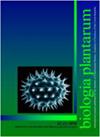Physiological and transcriptomic analysis of Pinus massoniana seedling response to osmotic stress
IF 0.9
4区 生物学
Q4 PLANT SCIENCES
引用次数: 2
Abstract
Masson pine (Pinus massoniana Lamb.) is an important tree species of high economic value in southern China, but osmotic stress threatens its growth and development. In this study, physiological measurements and RNA-Seq analysis were used to clarify the physiological and molecular responses of P. massoniana under osmotic stress. Osmotic treatment caused cell membrane damage and reactive oxygen species (ROS) accumulation in the tree seedlings, but it also increased their antioxidant enzyme (superoxide dismutase, peroxidase, and catalase) activities and osmotic substances (soluble sugars, proline, and trehalose) content so as to adjust to osmotic stress conditions. A total of 1 789 differentially expressed genes (DEGs) were identified by transcriptome sequencing, of which 962 were up-regulated and 827 genes down-regulated. A series of stress-induced genes associated with signal transduction, ROS-scavenging, osmotic regulation, late embryogenesis abundant (LEA) protein, pentatricopeptide repeat-containing protein, and transcription factors' regulation were distinguishable. This detailed investigation of the stress-responsive genes and pathways provides new insight into molecular mechanism of abiotic stress response in P. massoniana. Further, this study's data can contribute to genetic engineering or molecular breeding efforts to enhance osmotic resistance in P. massoniana stands.马尾松幼苗对渗透胁迫反应的生理和转录组学分析
马尾松(Pinus massonian Lamb.)是我国南方重要的高经济价值树种,但渗透胁迫威胁着其生长发育。本研究采用生理学测量和RNA-Seq分析方法,阐明了马尾松在渗透胁迫下的生理和分子反应。渗透处理引起了细胞膜损伤和活性氧(ROS)在幼苗中的积累,但也增加了它们的抗氧化酶(超氧化物歧化酶、过氧化物酶和过氧化氢酶)活性和渗透物质(可溶性糖、脯氨酸和海藻糖)含量,以适应渗透胁迫条件。转录组测序共鉴定出1789个差异表达基因,其中962个上调,827个下调。可区分一系列与信号转导、ROS清除、渗透调节、晚期胚胎发生丰富蛋白(LEA)、含五肽重复序列蛋白和转录因子调节相关的应激诱导基因。对马尾松胁迫反应基因和途径的详细研究为揭示马尾松非生物胁迫反应的分子机制提供了新的见解。此外,本研究的数据可以为提高马尾松林分渗透阻力的基因工程或分子育种工作做出贡献。
本文章由计算机程序翻译,如有差异,请以英文原文为准。
求助全文
约1分钟内获得全文
求助全文
来源期刊

Biologia Plantarum
生物-植物科学
CiteScore
2.80
自引率
0.00%
发文量
28
审稿时长
3.3 months
期刊介绍:
BIOLOGIA PLANTARUM is an international journal for experimental botany. It publishes original scientific papers and brief communications, reviews on specialized topics, and book reviews in plant physiology, plant biochemistry and biophysics, physiological anatomy, ecophysiology, genetics, molecular biology, cell biology, evolution, and pathophysiology. All papers should contribute substantially to the current level of plant science and combine originality with a potential general interest. The journal focuses on model and crop plants, as well as on under-investigated species.
 求助内容:
求助内容: 应助结果提醒方式:
应助结果提醒方式:


